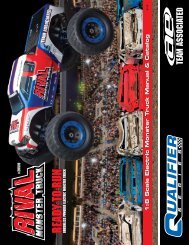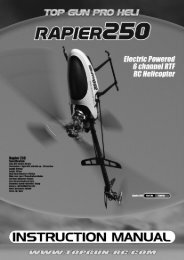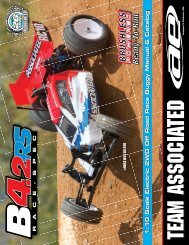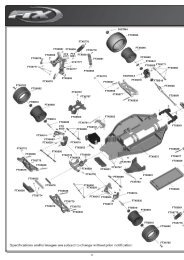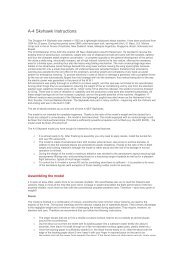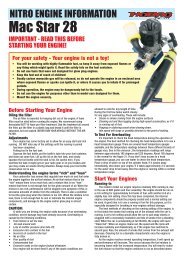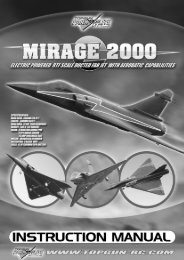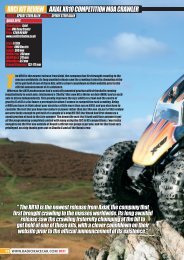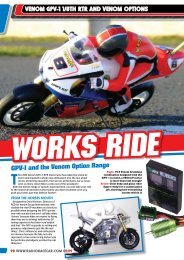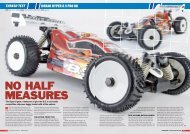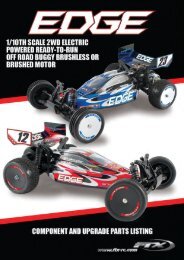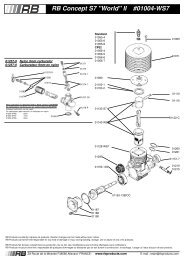Cermark Super ViperJet MkII PART1 - RC Universe
Cermark Super ViperJet MkII PART1 - RC Universe
Cermark Super ViperJet MkII PART1 - RC Universe
Create successful ePaper yourself
Turn your PDF publications into a flip-book with our unique Google optimized e-Paper software.
<strong>RC</strong>JI viperjet art. 11/3/05 1:00 pm Page 27<br />
VIPERJET<br />
MKII<br />
Countersunk Allen head screws sit flush in load-bearing washers in the<br />
fuselage, retaining the tailplane<br />
Aileron and flap linkages with lock-nuts and clevis retainer sleeves all<br />
correctly fitted<br />
supplied epoxy fibre board horns in the elevators<br />
to line up with the servo output arms. I cut<br />
slots with a razor saw and epoxied the horns in<br />
place, taking care to make sure the holes in the<br />
horn lined up with the hinge line. The servos<br />
are fixed using the aluminium brackets supplied,<br />
and wooden blocks set in the pre-cut<br />
holes in the underside of the tailplane halves.<br />
The elevators and fin are held in the fuselage<br />
by counter sunk 3 mm bolts which screw into<br />
the aluminium spars previously mentioned. A<br />
nice metal insert is imbedded into the fuselage<br />
at each screw position which gives a positive<br />
and solid fixing. This also makes everything<br />
easy to take apart for transportation.<br />
Wings<br />
The wings are constructed in the same way<br />
as the tailplane. This really is quality moulding<br />
at its best. Only the joints between the wing<br />
upper and lower halves need cleaning up. The<br />
epoxy fibre board horns are installed in the<br />
same way as for the elevators. Again the holes<br />
for the Robart hinges for the ailerons and flaps<br />
An aileron and a flap servo will be fitted to the<br />
hatch cover. Note the glue on the protruding<br />
hinge ends<br />
are all pre-drilled, all you are left to do is glue<br />
them in. However, the factory-installed balsa<br />
blocks for the hinges are too small, in my opinion<br />
as the Robart hinges protrude 10 mm into<br />
the wing space, so when glue is put into the<br />
hole it is pushed out into the wing. It would<br />
have been much better to have had bigger<br />
blocks so that any glue put into the hinge hole<br />
would have remained in contact with the hinge.<br />
Before gluing any hinges always put a smear of<br />
Vaseline on to the pivot area to stop any glue<br />
from jamming them solid. I shall cross-pin my<br />
hinges to be sure that they will not pull out.<br />
When installing the flaps I had to remove<br />
some of the edge of the lower wing surface so<br />
that the flap did not foul the wing skin when<br />
fully deployed. I removed 3 mm to give me the<br />
required movement. The servo hatch is precut,<br />
the flap and aileron servos are mounted on<br />
the inside surface with the supplied aluminium<br />
brackets and wooden blocks. I found that if a<br />
servo is positioned in the middle of the hatch<br />
there is a good chance that it will foul the top<br />
wing skin. More space can be found for the<br />
servos by moving them forward.<br />
There is a very nice wing fairing that attaches<br />
to the root wing rib. This is simply put on over<br />
the wing root and super glued in place, making<br />
for a very nice transition from wing to fuselage.<br />
The winglets at the tips are pushed on and held<br />
in place with two bolts. A nice touch are the<br />
lenses for the lights or strobes, whichever you<br />
prefer to fit. I lined the inside of the lens cavities<br />
with sticky backed silver paper to act as a<br />
reflector for the lights that I will fit at a later<br />
date. A screened single core wire had been<br />
installed in each wing, this could be used to<br />
connect to the lights or strobes, but the screen<br />
would have to carry the electric current. It may<br />
be more sensible to use this wire as a pull-wire<br />
to pull in a screened two-core cable, especially<br />
if strobe lights are installed.<br />
All that remains is to install the landing gear<br />
and jet-pipe and test fly the aircraft. This will<br />
be described in the next issue. <br />
Likes<br />
A model which is very pleasing to the eye<br />
and a good choice of jet scale subject<br />
Big compartments for engine and radio<br />
installation<br />
Cockpit and seats, not made from ABS.<br />
Fixing of fin and tailplane, easily taken<br />
apart for transportation.<br />
General finish of the whole model<br />
Dislikes<br />
Instruction manual - very little in the way<br />
of written instructions<br />
Balsa blocks for pin hinges too small, but<br />
hinges could be pinned<br />
Optional extras could be included in the<br />
kit as they are all needed<br />
Contacts:<br />
Manufacturer: <strong>Cermark</strong>.<br />
e-mail: cermark@aol.com<br />
Technical Support: tamjets@yahoo.com<br />
UK distributor: CML Distribution<br />
www.cmldistribution.co.uk<br />
E-mail: cml@cmldistribution.co.uk<br />
Tel: 01527 575349<br />
APRIL/MAY 2005 <strong>RC</strong>JI<br />
27



